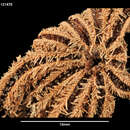en
names in breadcrumbs


“Genus Psalidaster nov.
DIAGNOSIS. Superficially resembling Saliasterias Koehler, but differing in having large, crossed pedicellariae of Notasterias type, abactinal and marginal spines single, the latter (surrounded by rosettes of crossed pedicellariae) forming two prominent lateral series. Abactinal and intermarginal papulae; no actinal plates or papulae; adambulacral plates diplacanthid, sporadically monacanthid and triplacanthid; actinostome small, mouth-plates small, adoral carina, long, narrow (5 or 6 plates); ambulacral furrow not abnormally wide; tube-feet slender, four ranked; abactinal skeleton proximally very irregularly reticulate, weak, disintegrated distally into separated small primary plates; gonopores conspicuous, two to each constricted actinal interradial area.
Type Ps. mordax sp.nov.
REMARKS. This new polybrachiate type cannot be confused with either Saliasterias Koehler or Cryptasterias Verrill, since its crossed pedicellariae, nearly r mm. long, have a highly characteristic form totally unlike the very small conventional pedicellariae of the above named genera. This is rather a fortunate circumstance for the abactinal skeleton, like that of so many Antarctic Asteriidae, is weak, reticulated, and without any special clues to relationship ; while the mostly monacanthid marginals are also without outstanding characteristics. The ovaries are small with large eggs, as in Cryptasterias, and open ventrally. The skin, though soft and finely wrinkled, is not of the thick pustulate type characteristic of Cryptasterias.
The crossed pedicellariae resemble those of Notasterias in having a broad base for the accommodation of heavier muscles, the jaws being swollen, with a large cavity. The constricted distal end of the jaw is produced into two principal teeth which interlock with those of the other jaw, instead of crossing. The suppression of one tooth would produce a pedicellaria closely similar to those which predominate on the inferomarginal and actinal spines of Notasterias armata (compare Fig. J, 4b with Fig. K, 2f, 2g).
As to the place of this genus in the system, I believe that it may be regarded as allied to Coscinasteriinae rather than to typical Asteriinae such as Diplasterias.”
(Fisher, 1940: 229)